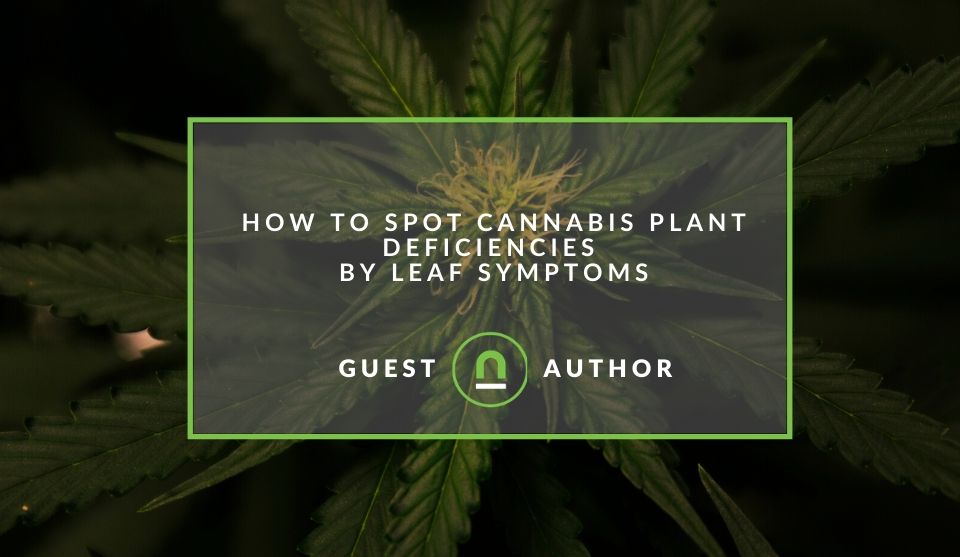Recent posts

Industry Experts
Common ASO Mistakes African App Developers Make
09 January 2026

Ace of Trades
The South African Industrial Tech Revolution
05 January 2026

nichemarket Advice
Why Video Production Companies Still Outshine AI
24 December 2025

Press Releases
Where You Can Find International Remote Jobs For South Africans
23 December 2025
Popular posts
Extravaganza
Trending Music Hashtags To Get Your Posts Noticed
24 August 2018
Geek Chic
How To Fix iPhone/iPad Only Charging In Certain Positions
05 July 2020
Extravaganza
Trending Wedding Hashtags To Get Your Posts Noticed
18 September 2018
Money Talks
How To Find Coupons & Vouchers Online In South Africa
28 March 2019
How To Spot Cannabis Plant Deficiencies By Leaf Symptoms
21 April 2020 | 0 comments | Posted by Jessica Smith in The Great Outdoors
Cannabis is a sturdy plant that requires minimum effort to lead you to a fruitful flowering season. Give the right amount of light, climate, and water, and you have healthy plants growing and spreading in no time. The growing interest in the cannabis sector has got many of us excited to soil our hands with some cannabis gardening.
The process of growing your very own plant is usually simple. Yet, the plant also needs some special care when it comes to mineral deficiencies that can affect its health as well as the buds.
Nutrient deficiencies could increase the risk of pathogen and pest infestations, and alleviate the growth potential and yield. As a novice cannabis enthusiast, you need to pay attention to your cannabis plant to ensure a healthy yield. One of the best features of cannabis is its sensitivity to respond to any deficiencies.
The plant shows apparent signs of the absence of any necessary ingredient for its growth through its leaves. So, all you need to do is pay heed to these symptoms, and you will know what your plant needs. Here are seven common leaf symptoms that indicate the absence of several deficiencies.
Start with a pH assessment
Before you begin searching for nutrients deficiencies in your cannabis plant, understand if there is proper pH balance in the soil. More often than we know, plants suffer from nutrients deficiencies due to an imbalance in pH levels. The root system is unable to deliver the nutrients from the soil to plants that cause deficiency symptoms to occur.
So, before you begin accessing your leaf for spots and discolourations, check the pH of the medium and ensure it falls between 5.5 and 6.8, which is ideal for the cannabis plant.
1. Yellowing of leaves from the bottom of the plant - Nitrogen deficiency
Nitrogen is a macronutrient essential for the growth of cannabis plants. It plays a vital role in photosynthesis and chlorophyll production that are important for the plant. It also helps in preparing amino acids that make up the proteins required for growth. Nitrogen is a critical nutrient, especially during the vegetative growth of the plant. The compound is usually stored in the leaves, and the cache is useful during the flowering phase.
Lack of nitrogen could lead to yellowing of leaves from the bottom of the plant, even when the top parts are green. The leaves could have brown spots at the margins and curl before they die. The deficiency could affect the entire plant soon. Try adding good quality NPK feeds that can improve the nitrogen levels effectively.
2. Purple petioles, brittle stems, lime green or yellow foliage – Sulphur deficiency
Sulfur is an immobile nutrient that is responsible for breaking down the fatty acids. It is also essential to produce oils and terpenes that contribute to the characteristics of the plant. For example, the Sativa Strains is an Indica dominant variety that has a sophisticated palette of flavours with vibrant tones of mint, chocolate, pine, and some spicy notes.
Terpenes present in the plant are responsible for these characteristics, and in the absence of sulfur, the plant turns out to be less potent. The element also plays a role in the formation of the structural organ in the plant.
In the absence of the right levels of the nutrient, the plant becomes brittle and droopy, and buds become necrotic. Epsom salt or sulfur-rich fertilizers can solve the problem easily. Sulfur deficiency also occurs due to the loss of phosphorus in many cases.
Look out for signs of pH imbalance or phosphorous deficiency before you supplement with sulfur.
3. Browning edges, dull and curled leaves, purplish discolouration – Phosphorous deficiency
Phosphorous deficiency can be hard to analyze at the initial stage as the symptoms are slightly subtle to notice. Cannabis plants with phosphorus deficiencies tend to have leaves that look green, but have a dull and washed out feel with light leaf tissue.
In later stages, you can see purplish discolouration in the leaf, and the edges will start to turn brown. If left unnoticed, large patches of the leaves could turn completely purplish-brown and die. The rest of the plant will turn yellowish-green and appear weak.
The nutrient is essential during the vegetative stage and could affect the yield, the strength of the roots, and the plant significantly. Using phosphorus sources, along with balancing water and temperature parameters, can help your plant to overcome the problem.
4. Burnt rusty older leaves with yellowing and curling of younger leaves – Potassium deficiency
Potassium is vital for developing a healthy root system in cannabis plants. The element, along with nitrogen, is responsible for chlorophyll and flower production. Potassium also enables a natural defence against fungal diseases and some pest infestation, and a deficiency could expose your plant to such damages.
Lack of right levels of potassium is visible through new leaves that show curled margins and yellowing on the surface. With time, the discolouration turns to brown spots and rusty tips.
The leaves also look heavily dehydrated when deficient of potassium due to the increased temperature of the foliage, which is an easy sign to notice in your plant.
You can depend on the nutrient supplement for your plants to provide potassium, however, make sure there isn’t an excess of nitrogen or calcium in the medium as these nutrients alleviate potassium absorption of your plant.
5. Yellow veins in older leaves and rusty spots near interveinal areas – Magnesium deficiency
Magnesium is the central atom of the chlorophyll compound and hence is essential for proper absorption of energy from the sun to carry out photosynthesis. Without magnesium, the plant loses its ability to properly absorb energy from light and convert into sugars and carbohydrate that is necessary for flowering.
Magnesium deficiency tends to become visible after 4 to 5 weeks of plant growth. The interveinal area is the best indication of the deficiency as spotting, discolouration occurs in this region, mostly.
New leaves start to look droopy and weak, and it can affect overall flowering significantly. Magnesium salts and worm castings are some of the best ways to counter magnesium deficiency.
6. Curling of lower leaves and brown spotting, withering roots and stunted growth - Calcium deficiency
Calcium plays a crucial role in defining the integrity of the plant. The nutrient is also necessary for proper root formation that determines the hydration and nutrition balance in the plant. Calcium deficiencies could also lead to excess deposits of certain nutrients, which can affect the quality of the plant.
It could cause the plant to lose strength and become fragile to breakage or fracture. The symptoms are initially visible in the older parts of the plant as compared to the new areas of growth.
Leaves curl and show irregular margins when deficient of calcium, and there is discolouration of the leaves and reduction in flower production due to this issue.
Calcium-rich fertilizers are the best means of countering the problem. Indoor hydroponic systems also have other ways of adding calcium to the medium for the plant to benefit.
7. Interveinal discolouration at the base of new leaves and yellowing between veins – Iron, Zinc or Manganese deficiency
Iron is necessary for chlorophyll development and nitrate and sulfate assimilation. The element plays an essential role in the respiratory process of the plant. Zinc is also critical for chlorophyll production and the development of plant tissue.
Manganese, on the other hand, helps in the cellular growth of the plant. The deficiency of any of these nutrients can lead to yellowing of petiole. Leaf discolouration is visible after a few days of deficiency. The problem eventually leads to necrotic leaves that start to drop.
Iron, Zinc, and Manganese are often applied together, as it is difficult to distinguish between the symptoms individually.
Watch out for these leaf symptoms and provide the right aids for your cannabis plant to overcome the deficiency and give a healthy yield. You should shop around online to ensure you get the best marijuana seeds you can find or search for the Best Cannabis seed in your store, or you can order online.
Tell us your story
Would you like to write for nichemarket just like Jessica has? Find out how to submit a guest post and when you're ready, you can contact us.
Are you looking to promote your business?
South African natural medicine businesses can create your free business listing on nichemarket. The more information you provide about your business, the easier it will be for your customers to find you online.
Registering with nichemarket is easy; all you will need to do is head over to our sign up form and follow the instructions. If you require a more detailed guide on how to create your profile or your listing, then we highly recommend you check out the following articles.
Recommended reading
If you enjoyed this post and have time to spare why not check out these related posts and dive deeper down the rabbit hole that is the cannabis treatment.
- How To Earn Cryptocurrency With Cannabis-Related Content
- Trending Hashtags For Cannabis Enthusiasts
- Popular Hashtags For Natural and Alternative Medicine
- 10 Benefits of Hemp Seed Oil for Great Health
- CBD for Anxiety - What Should I Know?
Tags: Gardening , Cannabis , Marijuana
You might also like
The Rise Of Trading Platforms In South Africa
16 December 2025
Posted by Gabriela Pelayes in Money Talks
Discover how the rise of digital trading platforms in South Africa is reshaping commodity markets, boosting accessibility, efficiency, and the future...
Read moreWhy Video Production Companies Still Outshine AI
24 December 2025
Posted by Che Kohler in nichemarket Advice
A review of traditional video production versus generative AI videos and why businesses might be tempted to go the cheaper route, but it might cost y...
Read more{{comment.sUserName}}
{{comment.iDayLastEdit}} day ago
{{comment.iDayLastEdit}} days ago
 {{blogcategory.sCategoryName}}
{{blogcategory.sCategoryName}}

